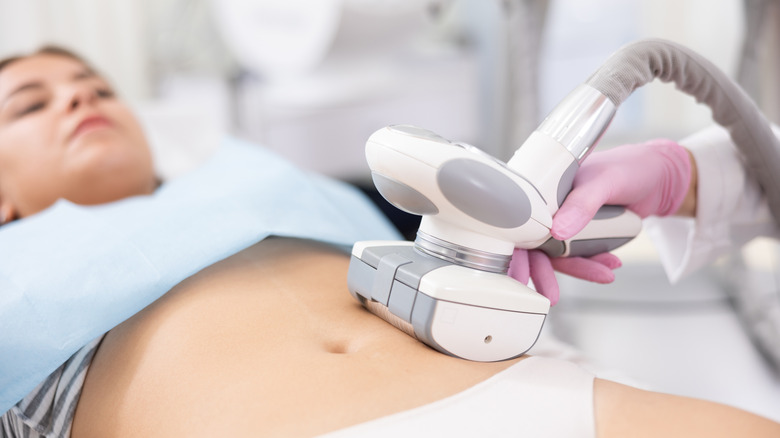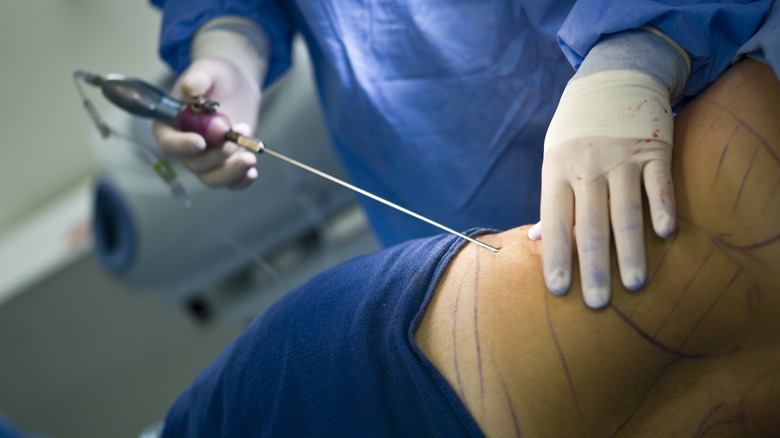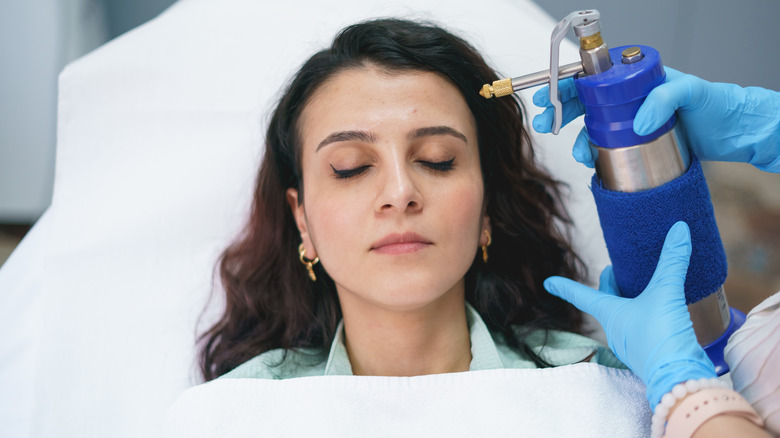What You Need To Know About The Risks Of Body Contouring
With our current beauty standards being dictated by the likes of Kim Kardashian, Kylie Jenner, and their ilk, popular plastic surgery trends are much more common than they once were. A beauty treatment that has caught everyone's attention in recent years is body contouring. It is usually done after one has already lost a lot of weight through other means and as a consequence has been left with hanging skin. It doesn't cut out the fat, but tackles what's left behind.
According to Cleveland Clinic, body contouring can be done surgically where liposuction or "lifts and tucks" can be used to cut off or shape the loose skin. On the other hand, lipolysis is a non-invasive, nonsurgical way to eliminate unwanted skin from targeted areas of the body by shaping it as desired.
Lipolysis relies on alternate methods like application of cold, heat, or targeted lasers, and is attractive to those who are afraid of going under the needle. However, as with any cosmetic procedure, both come with a set of risks, ranging from health complications to cosmetic issues. Surgeries can be dangerous, and non-invasive procedures may show little or no results.
By being aware of the risks of body contouring, you can decide if it is right for you or not.
Risks of surgical body contouring
When going in for a surgical procedure, be mindful of the following risks as laid out by the American Society of Plastic Surgeons: a reaction to anesthesia, the formation of blood clots that could lead to more serious issues like deep vein thrombosis and pulmonary embolism, large and unsightly scars, post-procedure bleeding, and the concerned area being infected or accumulating excess fluid. You may also experience an allergic reaction to the sutures or antiseptic lotion used during the procedure, so be sure to alert your surgeon to any allergies you are aware of (via Australian Society of Plastic Surgeons).
You may suffer from numbness in the part of the body that has been worked on or you could feel a strange sensation there. Your wound may not heal properly in some cases, or you may lose some extra skin. In some botched cases, the scars may even look worse than the loose skin did. And most importantly, even after the procedure is completed, you may be left with skin laxity or the skin may not look at par with its counterpart on the other side of your body. The Australian Society of Plastic Surgeons explains that this may require revisional surgery.
Usually, by choosing a seasoned surgeon, you will be alerted to these potential risks before you undertake the procedure. You shouldn't hesitate to ask questions and clear your doubts at that stage.
Risks of nonsurgical body contouring
Though nonsurgical procedures carry less risk than their surgical counterpart, there are still certain things you should be prepared for when you choose to go down this particular route, per Cleveland Clinic.
The FDA lists out some generic complications that may arise from nonsurgical body contouring procedures. These include pain during or following the procedure, swelling and bruising, and the formation of bumpy nodules under your skin that may not be visible to the naked eye.
If you decide to go in for fat freezing or cryotherapy, which are common forms of nonsurgical body sculpting, tell your healthcare professional if you have a sensitivity to cold, as that may not work well for you. Those with blood pressure or heart problems should also avoid cryotherapy, according to MedicalNewsToday. If, however, you do not have this problem, you may still face issues like bruising, skin discoloration, pain, excessive numbness, visible freeze burns, or nerve damage. Additionally, Cleveland Clinic explains that you may gain weight if fat cells appear in other areas of the body.
On the other hand, a heat-based non-invasive procedure may lead to unexpected blisters and burns, while laser therapies can lead to bruising (via Healthline). The use of sound waves for body contouring through ultrasound has been known to cause nerve damage in very rare cases, per FDA. If you are being treated with low-level light, pulsed magnetic field, or vibration-based procedures, you may experience sensitivity, skin pigmentation and itching, muscle soreness and cramps, and bruising.


